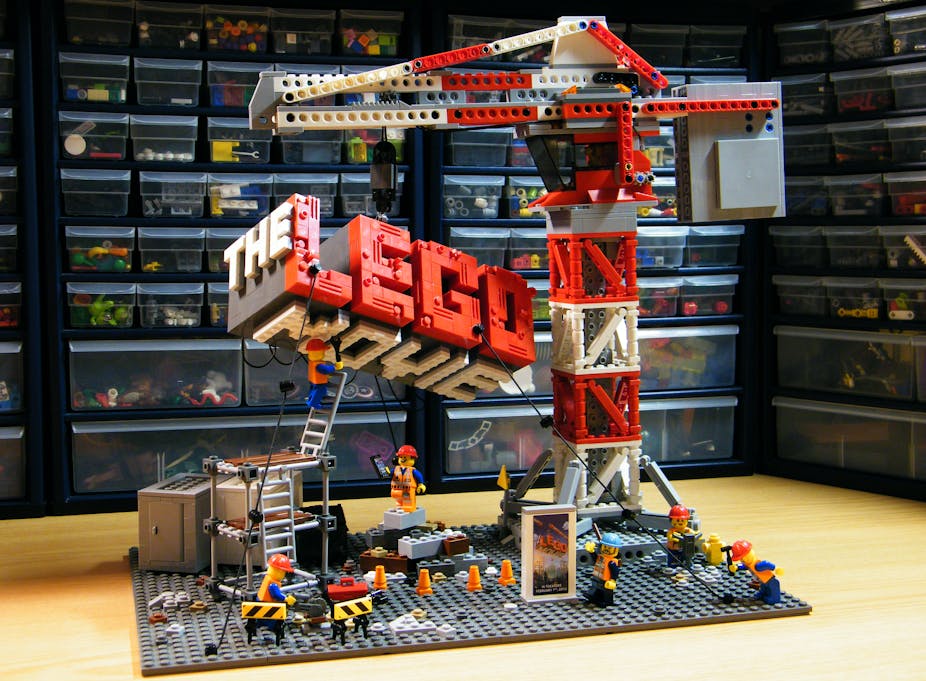I’m sitting here in my office, having made several false starts on this piece, and my phone has just buzzed. My five year old son – who an hour ago accompanied me to a packed screening of The Lego Movie – has gotten hold of my wife’s mobile and is using it to text me pictures.

The photo I just received shows a random assortment of violently scattered Lego pieces, clearly the immediate aftermath of a drop from some height onto a hard floor. An unhappy, helmet-clad minifig lies face-down in the middle of the carnage. The accompanying message informs me that this is “the bad guy bit”.
And I’m laughing. But it’s also got me thinking. If he’d sent me this yesterday, I’d most likely end up telling him off for not looking after his Lego properly. (I’d also be more than a little worried about the probability of this kind of play ending with a single 4x2 standard brick waiting patiently for me to step on it with my bare feet in the middle of the night.)
But not today.
A kids’ world free of adults?

I’ll be honest and admit that I went into The Lego Movie without high expectations. Having watched the previews, I’d put it firmly into the “triumph of commercialism over childhood” category and resolved myself not to see it. One of the longest-running discussions in children’s literature studies, and a conundrum that most children’s writers wrestle with on an ongoing basis, is the degree to which adulthood imposes itself and its values upon the lived experience of childhood.
I couldn’t imagine a film that, at first glance, appeared to serve as little else than an extension of merchandising being able to contribute much of benefit to the discussion.
And it’s an important discussion; one that has polarised opinions for decades. From British academic Jacqueline Rose who, in 1984, declared that the role played by adults in the mediation and creation of “children’s literature” meant that it was impossible, through to Perry Nodelman, the Canadian scholar who argued in 2008 that the inescapable presence of “the Hidden Adult” doesn’t so much negate the possibility of “children’s fiction” as define it.
In all the debate, one of the few common ideas that emerges is that the contemporary notion of childhood is very closely tied to the adult expectations and desires that construct and manage it.
Which is why, upon viewing the trailer for The Lego Movie, I couldn’t see the point of the film, other than as a vehicle to promote as many iterations of the toy as possible. Rather like the “Lego-ised” computer games one can buy (Lego Star Wars is a good example) where the Lego world and characters seem to serve no purpose other than as avatars for the characters and world of the original text.

Surprisingly, the film defied my expectations.
Yes – it’s about Lego. And no, it won’t do any harm to the Lego Corporation’s bottom line.
But it’s about a whole lot more than that. It’s a film of surprising complexity, and one that engages in a particularly liminal way with the boundaries of adulthood and childhood.
Emmet, the protagonist, functions not just as a vehicle for the plot, but also as a metaphor for the tabula rasa of childhood. In the course of his journey from “average” to being “The Special”, the film carefully and precisely teases apart the binaries of childhood and adulthood that are so clearly evident in the nature of Lego itself; a children’s toy that is nowadays just as prized and nostalgically glorified by adults.
During the first half, the movie rolls along with enough action and laughs to give the impression that, like most good family films, it has been deliberately packed with enough adult-access cultural references and in-jokes to make it fun (or at least bearable) for all concerned.
When, however, the plot takes on a particularly metafictive and postmodern twist in the final act, then the binary of children’s film/adult film unravels completely and the result is a film that will speak equally effectively, if differently, to both adult and child audiences, and which offers some serious food for thought on the issue of adulthood as a colonising force over childhood.
The Lego Movie is screening now.
If you are an academic or researcher working on film and would like to write for The Conversation please contact the Arts + Culture editor.
See also:
Brand connection and The Lego Movie – what’s going on?
The Lego Movie builds the case for Australian know-how

